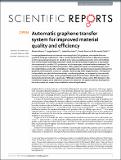Automatic graphene transfer system for improved material quality and efficiency
Author(s)
Bosca, Alberto; Pedros, Jorge; Martinez, Javier; Palacios, Tomas; Calle, Fernando
DownloadBosca-2016-Automatic Graphene.pdf (840.6Kb)
PUBLISHER_CC
Publisher with Creative Commons License
Creative Commons Attribution
Terms of use
Metadata
Show full item recordAbstract
In most applications based on chemical vapor deposition (CVD) graphene, the transfer from the growth to the target substrate is a critical step for the final device performance. Manual procedures are time consuming and depend on handling skills, whereas existing automatic roll-to-roll methods work well for flexible substrates but tend to induce mechanical damage in rigid ones. A new system that automatically transfers CVD graphene to an arbitrary target substrate has been developed. The process is based on the all-fluidic manipulation of the graphene to avoid mechanical damage, strain and contamination, and on the combination of capillary action and electrostatic repulsion between the graphene and its container to ensure a centered sample on top of the target substrate. The improved carrier mobility and yield of the automatically transferred graphene, as compared to that manually transferred, is demonstrated by the optical and electrical characterization of field-effect transistors fabricated on both materials. In particular, 70% higher mobility values, with a 30% decrease in the unintentional doping and a 10% strain reduction are achieved. The system has been developed for lab-scale transfer and proved to be scalable for industrial applications.
Date issued
2016-02Department
Massachusetts Institute of Technology. Department of Electrical Engineering and Computer ScienceJournal
Scientific Reports
Publisher
Nature Publishing Group
Citation
Bosca, Alberto, Jorge Pedros, Javier Martinez, Tomas Palacios, and Fernando Calle. “Automatic Graphene Transfer System for Improved Material Quality and Efficiency.” Scientific Reports 6 (February 10, 2016): 21676.
Version: Final published version
ISSN
2045-2322